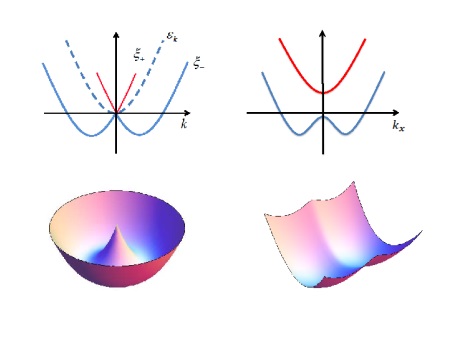

Schematic illustration of the single-particle spectra modified by spin-orbit coupling. The Rashba-type spin-orbit coupling can lead to a degenerate ring in momentum space for the lower branch of the single-particle dispersion spectra (left). The lower-branch dispersion spectrum under the NIST-type spin-orbit coupling (right) is less symmetric. These differences, as well as the hyperfine-spin dependence of the single-particle dispersion under spin-orbit coupling, give rise to rich physics in these systems. Credit: Science China Press
Ultracold atomic gases have been widely considered as ideal platforms for quantum simulation. Thanks to the clean environment and the highly tunable parameters in these systems, many interesting physical models can be simulated using cold atomic gases, and various novel many-body states have been prepared and probed experimentally. The recent experimental realization of synthetic gauge field in ultracold atomic gases has significantly extended the horizon of quantum simulation with cold atoms. As a special form of synthetic gauge field, synthetic spin-orbit coupling has attracted much attention recently.
Professor YI Wei from University of Science and Technology of China, Professor ZHANG Wei from Renmin University of China, and Professor CUI Xiaoling from Chinese Academy of Sciences reviewed the recent
The review article, entitled "Pairing superfluidity in spin-orbit coupled ultracold Fermi gases", was published in
In condensed-matter materials, spin-orbit coupling plays a key role in many interesting phenomena, such as quantum spin Hall effects, topological insulators, and topological superconductors. With the availability of synthetic spin-orbit coupling as a tool of quantum control, people hope to simulate various topological phases, the topological superfluid state in particular, in the highly controllable environment of ultracold Fermi gases. Indeed, recent theoretical studies have suggested that exotic superfluid phases and novel phenomena can be engineered with carefully designed configurations. By reviewing these theoretical studies, YI et al. discuss the exotic superfluid phases in systems with different spatial dimensions and with different forms of spin-orbit coupling. A fundamentally important effect of spin-orbit coupling is the modification of single-particle dispersion spectra.
The review focuses on how this effect leads to interesting pairing phases such as the topological superfluid state, various gapless superfluid states, the
Paper Link: Yi W, Zhang W, Cui X. Pairing superfluidity in spin-orbit coupled ultracold Fermi gases.

86-10-68597521 (day)
86-10-68597289 (night)

86-10-68511095 (day)
86-10-68512458 (night)

cas_en@cas.cn

52 Sanlihe Rd., Xicheng District,
Beijing, China (100864)

